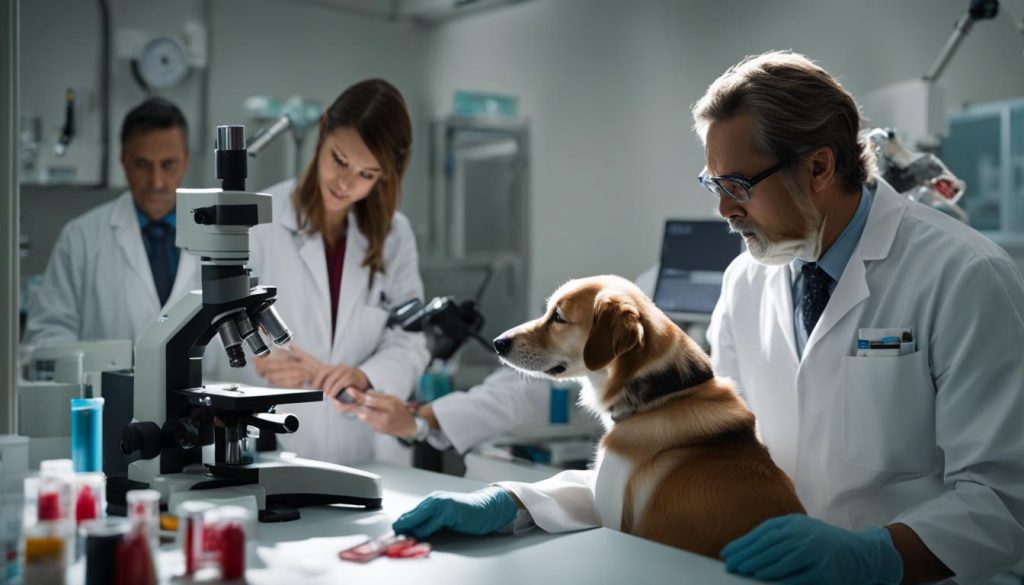Anemia in dogs can be a serious health condition that is often caused by various types of cancer. When dogs are diagnosed with cancer, it can lead to anemia due to the impact on the body’s ability to produce and maintain an adequate number of red blood cells. Common types of cancer that can cause anemia in dogs include leukemia, cancer of the spleen, liver, or kidneys.
Anemia restricts the body’s ability to carry oxygen to different parts of the body, which can result in symptoms such as lethargy, weakness, pale gums, bruising, and tarry stools. If left untreated, severe anemia can be fatal for dogs.
Key Takeaways:
- Various types of cancer can lead to anemia in dogs.
- Anemia restricts the body’s ability to carry oxygen, resulting in symptoms such as weakness and pale gums.
- Leukemia and cancer of the spleen, liver, or kidneys are common cancers that can cause anemia in dogs.
- Severe, untreated anemia can be fatal for dogs.
- Early detection and proper medical attention are crucial for the well-being of dogs with anemia.
Understanding Anemia in Dogs

Anemia in dogs occurs when there is a lower-than-normal red blood cell count, resulting in a decreased ability to carry oxygen. There are different types of anemia in dogs, including immune-mediated hemolytic anemia, blood loss anemia, aplastic anemia, non-regenerative anemia, and iron-deficiency anemia. These types of anemia can have various causes and require specific treatments.
Symptoms of anemia in dogs can include:
- Lethargy
- Weakness
- Pale gums
- Bruising
- Tarry stools
“Anemia in dogs occurs when there is a lower-than-normal red blood cell count.”
If you notice any of these symptoms in your dog, it is important to consult with a veterinarian for a proper diagnosis and treatment plan. Anemia can be a sign of an underlying health issue that needs to be addressed.
Each type of anemia requires a different approach to treatment. For example, immune-mediated hemolytic anemia may require blood transfusions and medications to suppress the immune system, while iron-deficiency anemia may require dietary changes and supplementation. It is crucial to work closely with your veterinarian to determine the best course of action for your dog.
Autoimmune Conditions and Anemia in Dogs

One of the most common causes of anemia in dogs is immune-mediated hemolytic anemia (IMHA). This condition occurs when the dog’s immune system mistakenly attacks and destroys its own red blood cells. IMHA can be triggered by certain medications, tick-borne infectious diseases, and certain types of cancers. It is important to identify and treat IMHA promptly, as severe cases can be life-threatening.
The exact cause of immune-mediated hemolytic anemia in dogs is not fully understood. However, it is believed to be a result of a malfunction in the immune system, leading to the destruction of red blood cells. Certain breeds, such as Cocker Spaniels, Old English Sheepdogs, and Irish Setters, are more susceptible to developing IMHA.
Symptoms of immune-mediated hemolytic anemia in dogs include:
- Weakness and lethargy
- Pale gums
- Rapid breathing or difficulty breathing
- Dark or bloody urine
- Jaundice (yellowing of the skin and eyes)
Immediate veterinary attention is crucial if you suspect your dog has IMHA. The diagnosis is typically made through blood tests, which will show a reduced red blood cell count and signs of destruction. Treatment for immune-mediated hemolytic anemia in dogs often involves blood transfusions to stabilize the dog’s red blood cell count and medications to suppress the immune system’s attack on the cells. Close monitoring and follow-up care are necessary to manage the condition and prevent relapses.
| Cause | Prevalence | Treatment |
|---|---|---|
| Medications | Common | Discontinue use of the medication and supportive care |
| Tick-borne infectious diseases | Varies by region | Treatment with appropriate medications |
| Certain types of cancers | Less common | Treatment will depend on the specific cancer |
Bleeding Splenic Masses and Anemia in Dogs

Masses on the spleen can have serious implications for the health of dogs, particularly when they cause bleeding and lead to a condition known as hemoabdomen. Bleeding splenic masses, whether benign or cancerous, can result in severe blood loss anemia. This condition is more commonly observed in large breed dogs, and early detection and treatment are crucial for a successful outcome.
Symptoms of Hemoabdomen in Dogs
Recognizing the symptoms of hemoabdomen in dogs is essential for prompt intervention. Some common signs to watch out for include pale gums, elevated heart rate, vomiting, labored breathing, and collapse. If you notice any of these symptoms in your dog, it is important to seek immediate veterinary attention as untreated hemoabdomen can be life-threatening.
Treatment for Bleeding Splenic Masses
The treatment for bleeding splenic masses in dogs typically involves emergency surgery to remove the affected spleen. This may include a splenectomy, which is the complete removal of the spleen, or a partial splenectomy, depending on the extent of the mass and the dog’s overall health. The surgery aims to stop the bleeding and prevent further complications. Post-operative care may involve blood transfusions, pain management, and close monitoring to ensure a smooth recovery.
| Signs of Hemoabdomen in Dogs | Treatment for Bleeding Splenic Masses |
|---|---|
| – Pale gums | – Emergency surgery (splenectomy or partial splenectomy) |
| – Elevated heart rate | – Blood transfusions |
| – Vomiting | – Pain management |
| – Labored breathing | – Post-operative monitoring |
| – Collapse |
By addressing bleeding splenic masses in a timely manner, veterinarians can help improve the prognosis for dogs with hemoabdomen. It is important to closely follow the post-operative care instructions provided by the veterinarian to ensure the best possible outcome for your furry companion.
Other Causes of Anemia in Dogs

Besides autoimmune conditions and bleeding splenic masses, anemia in dogs can be caused by a variety of factors. These include parasites, toxins, bleeding from trauma or surgery, gastrointestinal bleeding, bone marrow disease, kidney disease, and chronic diseases. Certain medications and nutritional deficiencies can also contribute to the development of anemia in dogs.
Parasites such as fleas, ticks, and worms can lead to anemia in dogs by causing blood loss or by affecting the dog’s ability to absorb essential nutrients. Toxins, such as certain plants or chemicals, can damage the red blood cells and result in anemia. Injuries or surgical procedures that cause significant bleeding can lead to acute anemia if not properly treated.
Chronic conditions, such as kidney disease or bone marrow disease, can interfere with the production of red blood cells or their normal function. Anemia can also be a secondary symptom of underlying diseases, including immune-mediated diseases or certain types of cancers. It’s important for veterinarians to conduct thorough diagnostic tests to identify the root cause of anemia in dogs and provide appropriate treatment.
Possible Triggers for Anemia in Dogs:
- Parasites (fleas, ticks, worms)
- Toxins (plants, chemicals)
- Bleeding from trauma or surgery
- Gastrointestinal bleeding
- Bone marrow disease
- Kidney disease
- Chronic diseases
Understanding the possible triggers for anemia is crucial in both prevention and treatment. Pet owners should ensure their dogs are protected against parasites, provide a safe environment free from harmful toxins, and seek immediate veterinary attention for any injuries or signs of illness. Regular check-ups and routine blood tests can help detect and manage anemia in its early stages, increasing the chances of successful treatment and improving the overall health of dogs.
Table: Possible Causes of Anemia in Dogs
| Cause | Description |
|---|---|
| Parasites | Fleas, ticks, worms |
| Toxins | Plants, chemicals |
| Bleeding | Trauma, surgery |
| Gastrointestinal bleeding | Ulcers, tumors |
| Bone marrow disease | Myelofibrosis, myelodysplasia |
| Kidney disease | Renal failure, glomerulonephritis |
| Chronic diseases | Heart disease, liver disease |
Diagnosis and Treatment of Anemia in Dogs

Diagnosing anemia in dogs involves a thorough evaluation by a veterinarian. The first step is performing a complete blood count (CBC) test to determine the red blood cell count and assess the severity of the anemia. This test provides valuable information about the dog’s overall health and helps identify potential underlying causes of anemia. Additional tests, such as fecal exams, blood samples, urinalysis, and imaging exams, may be necessary to further investigate the underlying cause of the anemia.
Once the cause of anemia is determined, appropriate treatment can be initiated. The goal of treatment is to stabilize the dog’s blood and address the underlying cause. Blood transfusions may be necessary in severe cases to replenish the red blood cell count and improve oxygen delivery. Medications, such as immunosuppressants or antibiotics, may be prescribed depending on the underlying cause of anemia. In cases where anemia is caused by parasites, deworming medications may be administered. Surgical intervention may also be required for cases involving bleeding splenic masses or other abdominal conditions.
It is important to note that the treatment approach may vary depending on the specific cause and severity of anemia. Regular monitoring and follow-up appointments with the veterinarian are essential to track the dog’s progress and adjust the treatment plan if needed. In some cases, long-term management of the underlying condition may be necessary to prevent recurrence of anemia.
Table: Common Diagnostic Tests for Anemia in Dogs
| Test | Purpose |
|---|---|
| Complete Blood Count (CBC) | Determines the red blood cell count and assesses the severity of anemia. |
| Fecal Exam | Helps identify any parasitic infections that may be causing anemia. |
| Blood Sample | Allows for further analysis, such as blood chemistry panels, to evaluate organ function and assess for underlying diseases. |
| Urinalysis | Helps evaluate kidney function and detect any abnormalities. |
| Imaging Exams | Includes X-rays, ultrasounds, or CT scans to assess the organs and look for any abnormalities or masses. |
Proper diagnosis and treatment are crucial for dogs with anemia to improve their quality of life and overall prognosis. It is essential to work closely with a veterinarian to ensure the best possible care for a dog suffering from anemia.
Prognosis and Survival Rates for Dogs with Anemia
An accurate prognosis for dogs with anemia depends on several factors, including the underlying cause, the stage of the disease, and the overall health of the dog. While some forms of anemia can be managed successfully with appropriate treatment, others may have a more guarded prognosis.
In cases where anemia is caused by a treatable condition, such as iron-deficiency anemia or certain parasitic infections, the prognosis is generally favorable with timely intervention. With proper treatment and management, dogs can experience a full recovery and regain their normal red blood cell count.
However, when anemia is caused by more serious conditions like immune-mediated hemolytic anemia or certain types of cancer, the prognosis may be more variable. These conditions often require long-term management and can be more challenging to treat. Survival rates can vary depending on the specific condition and the response to treatment.
Regular monitoring and follow-up veterinary care are essential for dogs with anemia. This helps ensure that the underlying cause is well-managed and any necessary adjustments to treatment can be made. By closely monitoring the dog’s condition and providing appropriate care, pet owners can help improve the chances of a successful outcome and maximize their pet’s quality of life.
Survival Rates for Dogs with Anemia
The survival rates for dogs with anemia vary depending on the underlying cause and the response to treatment. While some forms of anemia can be successfully managed with proper treatment, others may require ongoing veterinary care and long-term management. It is important to note that individual cases can differ, and survival rates should be discussed with a veterinarian.
Here is an overview of survival rates for dogs with anemia based on different underlying causes:
| Underlying Cause | Survival Rate |
|---|---|
| Iron-deficiency anemia | High – with appropriate treatment and dietary adjustments, dogs can recover fully. |
| Immune-mediated hemolytic anemia | Variable – survival rates depend on the severity of the condition and the response to immunosuppressive medications. |
| Leukemia | Variable – survival rates depend on the stage of the disease and the response to chemotherapy or other treatments. |
| Bleeding splenic masses | Variable – survival rates depend on the extent of blood loss and the success of emergency surgery to remove the mass. |
| Other cancers (e.g., liver or kidney cancer) | Variable – survival rates depend on the specific type and stage of cancer, as well as the response to treatment. |
It is important to consult with a veterinarian to determine the most accurate prognosis and survival rate for a specific case of anemia in a dog. The veterinarian can provide personalized information based on the dog’s individual circumstances and the underlying cause of the anemia.
Prevention of Anemia in Dogs

Preventing anemia in dogs is crucial for maintaining their overall health and well-being. By implementing a few key strategies, pet owners can help to detect illnesses early and take necessary precautions to prevent anemia from occurring.
Maintaining a Balanced Diet
A nutrient-rich diet is essential for ensuring a dog’s immune system stays strong and healthy. Providing a well-balanced diet that includes high-quality proteins, vitamins, and minerals can help support red blood cell production and prevent anemia. It is important to consult with a veterinarian to determine the specific dietary needs of individual dogs based on their age, breed, and overall health.
Regular Check-ups and Preventive Medicine
Scheduling regular check-ups with a veterinarian is essential for early detection of any potential illnesses or underlying conditions that may lead to anemia. During these check-ups, veterinarians may perform blood tests, fecal tests, and other diagnostic procedures to monitor a dog’s overall health and identify any potential issues. Following the veterinarian’s recommendations for preventive medicine, such as deworming and vaccinations, can also help prevent anemia and other health problems.
Environmental Safety
Creating a safe environment for dogs is another important aspect of preventing anemia. Avoid exposing dogs to toxins, such as certain cleaning products or pesticides, that could potentially harm their health. Additionally, preventing trauma and injury by ensuring a safe and secure living space can reduce the risk of blood loss anemia.
| Diet and Nutrition | Regular Check-ups | Environmental Safety |
|---|---|---|
| Provide a nutrient-rich diet | Schedule regular check-ups with a veterinarian | Avoid exposure to toxins |
| Include high-quality proteins, vitamins, and minerals | Monitor overall health and detect illnesses early | Ensure a safe and secure living environment |
| Consult with a veterinarian for specific dietary needs | Follow recommendations for preventive medicine | Prevent trauma and injury |
Preventing anemia in dogs requires a proactive approach to their health and wellbeing. By maintaining a balanced diet, scheduling regular check-ups, and ensuring environmental safety, pet owners can significantly reduce the risk of anemia in their beloved companions. Early detection of illnesses and immediate veterinary attention are key factors in preventing anemia and other health issues. With proper care and preventive measures, dogs can lead happy, healthy lives free from the debilitating effects of anemia.
Wrapping Up
In conclusion, anemia in dogs is a serious condition that can be caused by various factors, including cancer. It is important for pet owners to be vigilant and recognize the symptoms of anemia in their dogs. Lethargy, weakness, pale gums, bruising, and tarry stools are all potential signs of anemia.
Seeking veterinary help is crucial to properly diagnose and treat anemia in dogs. A complete blood count (CBC) test is typically performed to determine the red blood cell count, and further tests may be needed to identify the underlying cause. Treatment options may include blood transfusions, medications, deworming, or surgery, depending on the specific situation.
Prevention plays a key role in managing anemia in dogs. Maintaining their overall health through a nutrient-rich diet, regular check-ups, and preventive medicine can help prevent the development of anemia. Early detection of potential illnesses is essential in ensuring the well-being of our furry companions.
By staying informed and proactive, pet owners can improve the quality of life for their dogs and increase their chances of recovery from anemia. Remember to consult with a veterinarian for personalized advice and guidance for your beloved pets.
FAQ
What kind of cancer causes anemia in dogs?
Various types of cancer can cause anemia in dogs, including leukemia, cancer of the spleen, liver, or kidneys.
What are the symptoms of anemia in dogs?
Symptoms of anemia in dogs can include lethargy, weakness, pale gums, bruising, and tarry stools.
What is immune-mediated hemolytic anemia (IMHA)?
IMHA is a common cause of anemia in dogs, where the immune system attacks and destroys their own red blood cells.
How is immune-mediated hemolytic anemia treated?
Treatment for IMHA typically involves blood transfusions and medications to suppress the immune system.
What are bleeding splenic masses?
Masses on the spleen, whether benign or cancerous, can lead to hemoabdomen in dogs, a severe blood loss anemia.
What are the symptoms of hemoabdomen in dogs?
Symptoms of hemoabdomen include pale gums, elevated heart rate, vomiting, labored breathing, and collapse.
What are some other causes of anemia in dogs?
Other causes of anemia in dogs can include parasites, toxins, bleeding from trauma or surgery, gastrointestinal bleeding, bone marrow disease, kidney disease, and chronic diseases.
How is anemia in dogs diagnosed?
Veterinarians perform a complete blood count (CBC) test to determine the red blood cell count. Further tests may be needed to identify the underlying cause.
How is anemia in dogs treated?
Treatment for anemia in dogs involves stabilizing the blood and addressing the specific cause, which may include blood transfusions, medications, deworming, or surgery.
What is the prognosis for dogs with anemia?
The prognosis for dogs with anemia depends on the underlying cause and the dog’s overall health. Timely intervention and proper medical attention can improve the chances of a successful recovery.
How can anemia in dogs be prevented?
Preventing anemia in dogs involves maintaining their overall health through a nutrient-rich diet, avoiding exposure to toxins, and scheduling regular check-ups with the veterinarian.






